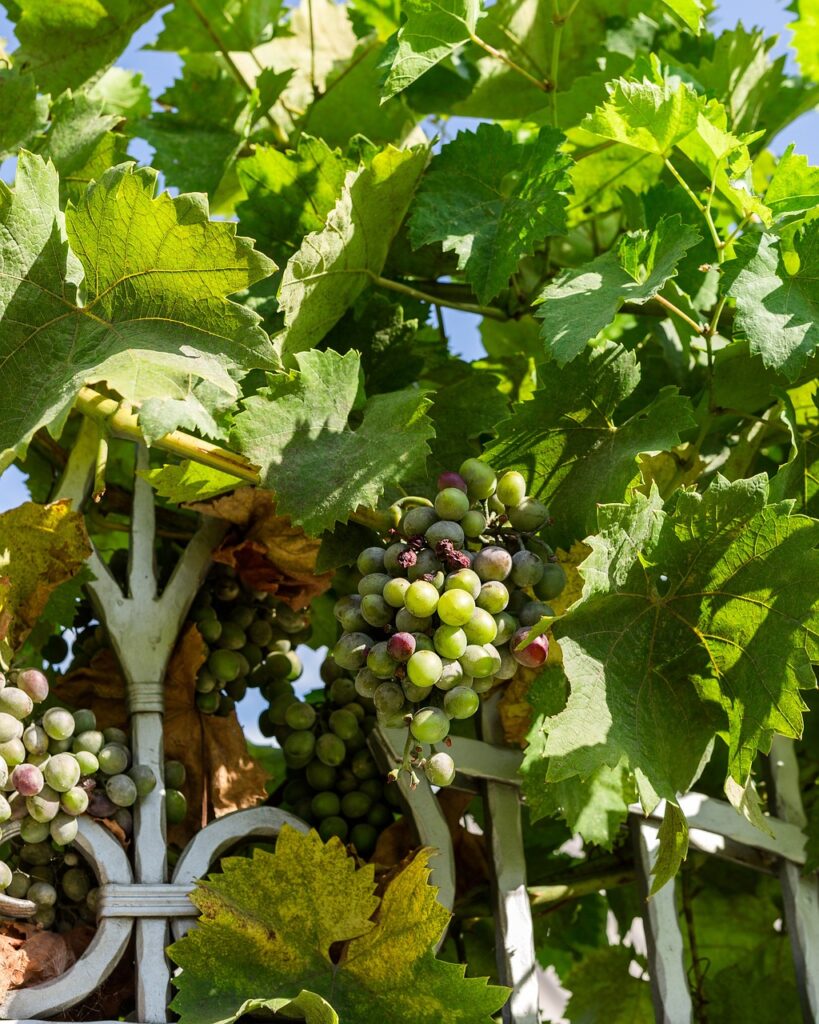
Introduction:
The secrets to successful grape vine growth in your backyard with our comprehensive guide. Growing grape vines can be a rewarding endeavor, providing delicious fruit and beautiful foliage. In this guide, We'll share essential tips and tricks to help you thriving grape vines and enjoy bountiful harvests in your own backyard.Learn effective techniques for growing grape vines. Discover tips for nurturing and maintaining healthy vines in your garden.
Select a site that receives full sunlight for at least six to eight hours per day. Grape vines thrive in sunny locations that promote optimal fruit ripening and sugar production.
Ensure the soil is well-draining and fertile, with a pH level between 6.0 and 6.5. Sandy loam or loamy soil types are ideal for grape vine growth, providing adequate drainage and nutrient availability.

Planting grape vines in your backyard can be a rewarding endeavor, providing delicious fruit and adding beauty to your landscape. Follow these steps to ensure successful establishment and growth of your grape vines:
By following these steps, you can effectively plant grape vines in your backyard and set the stage for a bountiful harvest of delicious grapes. With proper care and maintenance, your grape vines will thrive and provide you with years of enjoyment.
Pruning grape vines during the dormant season is a crucial aspect of vineyard management, as it promotes optimal growth, fruit production, and overall vine health. The dormant season typically occurs in late winter to early spring, before the onset of bud break when the vines are in their inactive state. Pruning during this period allows for easier access to the vines and reduces the risk of damage to new growth.
Pruning during the dormant season stimulates new growth by removing old, unproductive wood and encouraging the development of fruitful canes and spurs.
Removing dead, diseased, or damaged wood reduces the risk of fungal infections and pests, which can spread rapidly in crowded vineyards.
Thinning out the canopy allows for better airflow and sunlight penetration, which helps reduce humidity levels and minimize the risk of fungal diseases such as powdery mildew and downy mildew.
Inspect each vine carefully to identify areas of dead, damaged, or overcrowded wood that need to be removed. Prune selectively to maintain a balanced vine structure and promote uniform fruit ripening.
Use sharp, clean pruning shears or loppers to make clean cuts without damaging the vines. Disinfect pruning tools between vines to prevent the spread of diseases.
Begin by removing any dead, diseased, or damaged wood, cutting back to healthy tissue. Next, selectively thin out overcrowded areas, removing excess canes and shoots to improve airflow and sunlight penetration.
Training Methods:
Training grape vines to a specific trellis system or support structure is essential for optimizing vine growth, canopy management, and fruit quality. Different training methods, such as spur pruning or cane pruning, can be employed depending on the desired vineyard layout and grape variety.
Spur pruning involves selecting and maintaining a permanent framework of cordons or arms along the trellis wires, from which short, fruit-bearing spurs are retained each year.
During pruning, select healthy, well-positioned shoots from the previous season's growth and retain them as spurs, usually 2 to 3 buds in length. Remove excess growth and older wood to maintain the desired spur density and encourage fruit production.
Cane pruning involves selecting and training one or more long, fruit-bearing canes each year, which are then tied to the trellis wires for support.
During pruning, select 1 to 3 vigorous canes from the previous season's growth, ideally with 15 to 20 buds per cane. Cut back the selected canes to the desired length and remove excess growth and older wood to maintain vine balance.
Preventing pests and diseases is crucial for maintaining vine health:
Regularly inspect grape vines for signs of pest infestation, including aphids, grape leafhoppers, and powdery mildew. Use integrated pest management strategies to control pests while minimizing environmental impact. Regular inspection of grape vines is essential for early detection of pest infestations. Some common pests that affect grape vines include:
Aphids: These small insects feed on sap and can cause distortion of leaves and stunted growth.
Grape Leafhoppers: Leafhoppers can transmit viruses and cause damage by feeding on plant sap, leading to yellowing of leaves and reduced vigor.
Powdery Mildew: Powdery mildew is a fungal disease that appears as a white powdery coating on leaves, stems, and fruit clusters, affecting photosynthesis and fruit quality.
Integrated Pest Management (IPM) Strategies
Integrated pest management (IPM) strategies involve using a combination of techniques to control pests while minimizing environmental impact. Some IPM strategies for grape vine pest management include:
Biological Control: Introduce natural predators or parasites of pests to reduce their populations. For example, ladybugs can help control aphid populations.
Cultural Practices: Implement cultural practices such as proper vine spacing, canopy management, and weed control to reduce pest habitat and promote vine health.
Chemical Control: Use pesticides judiciously and as a last resort, choosing products with minimal environmental impact and targeting specific pests.
Practice good sanitation by removing and disposing of diseased plant material promptly. Apply fungicides preventatively to protect against common grape diseases such as powdery mildew and downy mildew.
Disease prevention is another critical aspect of grape vine management, particularly for fungal diseases like powdery mildew and downy mildew. Key disease prevention strategies include:
Sanitation: Remove and dispose of diseased plant material promptly to prevent the spread of pathogens. This includes pruning out infected shoots and removing fallen leaves and fruit clusters.
Fungicide Application: Apply fungicides preventatively to protect grape vines against common fungal diseases. Timing of fungicide applications is crucial and should be based on disease risk and weather conditions.

A: Yes, grape vines can be grown in large containers on patios or balconies, provided they receive adequate sunlight, water, and support for climbing.
A: Grape vines typically begin producing fruit within 2 to 3 years after planting, although this timeline may vary depending on the vine variety and growing conditions.
A: Common pests include aphids, spider mites, and grapevine leafhoppers, while diseases such as powdery mildew, downy mildew, and botrytis can also affect grape vines.
A: While grape vines do require some maintenance, including pruning, watering, and pest management, they are relatively low-maintenance compared to some other fruit crops.
A: Grape vines benefit from annual fertilization with a balanced fertilizer in early spring before new growth begins. Use a fertilizer specifically formulated for fruit-bearing vines and follow the manufacturer's recommendations for application rates.
A: While grape vines can grow without a trellis or support structure, providing support encourages upward growth, maximizes sunlight exposure, and makes maintenance tasks such as pruning and harvesting easier.
A: Ripe grapes will have a rich color, such as purple for red varieties or green for white varieties, and will feel slightly soft to the touch. Taste a few grapes to assess their sweetness and flavor before harvesting.
A: Yes, it is possible to grow organic grapes using cultural practices, biological controls, and organic-approved pesticides to manage pests and diseases while maintaining soil and ecosystem health.
A: Yes, grape vines can be propagated from hardwood cuttings taken from dormant vines in late winter or early spring. Choose healthy, disease-free wood for best results.
A: In colder regions, select cold-hardy grape varieties and provide winter protection, such as wrapping vines in burlap or burying them under mulch, to prevent cold damage and ensure vine survival.
With the right care and attention, growing grape vines in your backyard can be a rewarding experience. By following the tips and techniques outlined in this guide, you can cultivate healthy and productive grape vines and enjoy the fruits of your labor for years to come. Start your backyard grape vine growth journey today and savor the delicious flavors of homegrown grapes in your own backyard.
Note : If you want to know and ask more questions about agriculture, you can contact here

Copyright 2024 Farming Solutions